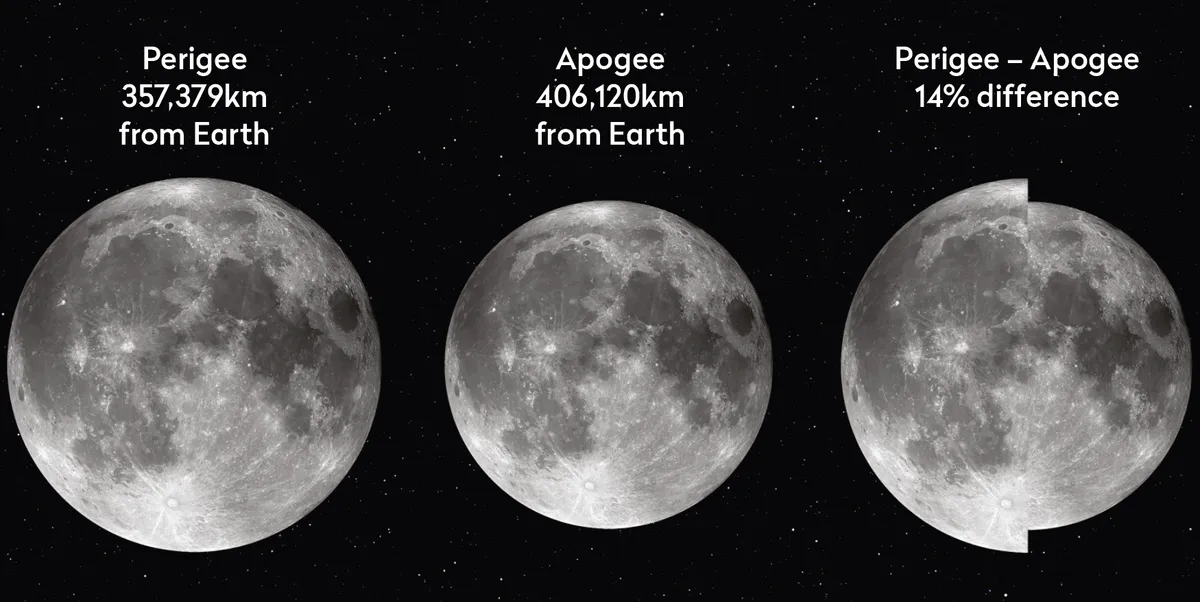When the full Moon rises this week, it will be the biggest, brightest full Moon of the year.
The 4–6 November 2025 full Moon is a so-called supermoon, which is the name given to a full Moon that occurs when the Moon is closest to Earth.
It's also the Beaver Moon for 2025.
But what do these terms mean, and are we really about to witness a gigantic full Moon of epic proportions?
Get weekly stargazing advice and Moon phases delivered to your email inbox by signing up to our e-newsletter

Biggest, brightest full Moon of the year?
What makes a supermoon? These big, bright full Moons occur because the Moon's orbit around Earth isn't a perfect circle.
Instead, the Moon's orbit is elliptical, or slightly egg-shaped. That means sometimes the Moon is closer to Earth than at other times.
When it's closest to Earth, the Moon is at perigee. When it's farthest from Earth, the Moon is at apogee.
A perigee full Moon can appear up to 30% brighter and 14% bigger than a full Moon at apogee.

The November 2025 supermoon is the second of three supermoons in 2025, and it's the biggest and brightest of them all.
That's because this full Moon will be the closest to Earth than any other full Moon of 2025.
At its closest point, the November 2025 full Moon will be 356,980km (221,818 miles) from Earth, according to AstroPixels.com, a fantastic online resource hosted by Moon and eclipse expert Fred Espenak.
And according to NASA, the average distance between Earth and the Moon is 384,400km, (238,855 miles) which puts into perspective just how much closer the November full Moon will be.

Super Beaver Moon
As well as being a supermoon, the November 2025 full Moon is the Beaver Moon.
The term 'Beaver Moon' is one of the many informal names given to each full Moon throughout the year.
These lunar nicknames mark major changes and events occurring in nature during the month in which the full Moon rises.
November's full Moon is known as the Beaver Moon because this is the time of year when beavers are most active, preparing for the cold winter months that lie ahead.
As is the case with every full Moon nickname, from the Wolf Moon to the Strawberry Moon, these are only nicknames, and don't indicate that the Moon will look any different than usual.
In other words, you shouldn't expect November's full Moon to look anything like a beaver!

What the supermoon will look like
Given the stats, you could be forgiven for thinking we're about to witness a spectacularly large full Moon, brighter than any full Moon we've ever seen.
In truth, you are unlikely to notice that the Moon is bigger or brighter than any other full Moon of the year.
The difference between a 'regular' full Moon and a supermoon is imperceptible to the naked eye, even when it's the 'biggest, brightest' full Moon of the year.
A better way to mark it is photographically, and it is possible to capture photos to show the changing size of the Moon.
Any online outlets promising an enormous full Moon should be taken with a pinch of salt.

That being said, a full Moon, 'super' or not, is a spectacular sight at any time of the year, and certainly not something to be taken for granted.
Our advice would be to observe the Moon every night this week and enjoy it for the beautiful sight that it is.
A full Moon is easily seen with the naked eye, making it a great event for beginners and young children.
Below are some key facts and observing tips to help you get the most out of this November 2025 supermoon.

November 2025 supermoon, key facts
You can enjoy the sight of the full Moon from 4–6 November.
It will rise in the east-northeast area of the sky each night, from around 15:30, rising slightly later each night.
That puts the November supermoon's rise time just at the point of sunset.
You'll need a clear northeastern horizon to see it rise, and if you can do so, you'll see it poke above the horizon in the evening twilight.
If you do see it rise above the horizon, you may notice that is looks abnormally large. This is nothing to do with it being a supermoon, but rather an optical effect known as the Moon illusion that occurs when you observe any full Moon close to the horizon.

As the November full Moon climbs higher in the sky, it will move towards the southeast.
By midnight, it will be high in the sky, and you should now be able to see the beautiful constellation Orion in the southeast and bright planets Jupiter and Saturn in the east and southwest, respectively.
After midnight, the supermoon will begin to descend towards the western horizon, which it will dip below after sunrise.
For more advice and ways to enjoy the November 2025 full Moon, read our guide on how to make the most of a supermoon.
Share your supermoon observations and images with us by emailing contactus@skyatnightmagazine.com

